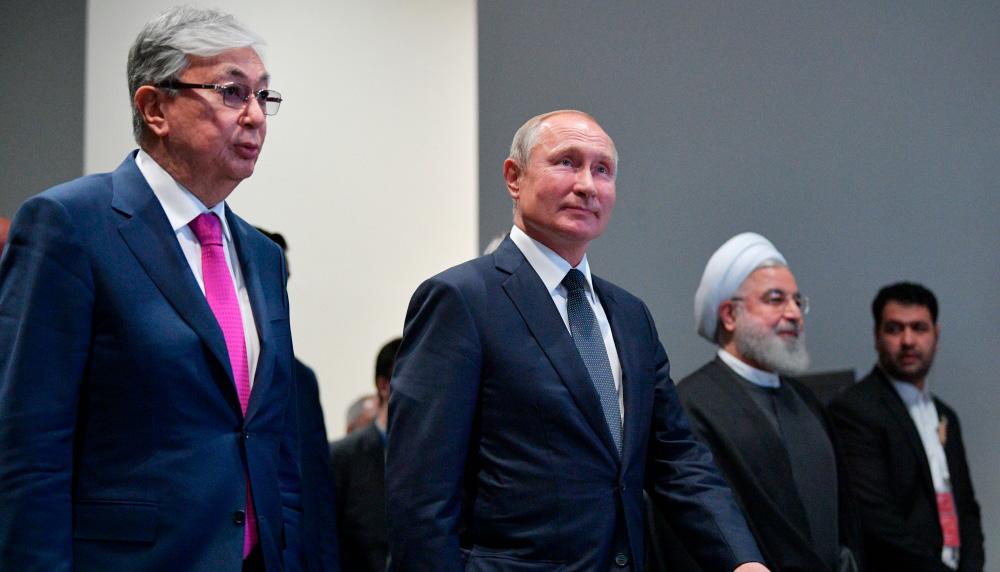Yerevan needs to create concrete and real road map for developing its relations with Beijing. China is a young, eastern superpower of the World, which provides tremendous investments. It is already in the neighborhood of Armenia, but Armenian diplomacy still was not able to bring any Chinese serous investment to Armenia. Armenia is also a member of EAEU, which provides an opportunity to Yerevan to implement its policy towards Beijing in multilateral level as well, using the fact that Russia and China decided in 2015 to conjunct EAEU and China’s BRI and that the Agreement on Trade and Economic Cooperation between the Eurasian Economic Union and the People’s Republic of China was signed on May 17, 2018 in Astana.
According to this document, the Parties agreed to develop cooperation in agriculture, energy, transport, industrial cooperation, information and communication infrastructure, technology and innovation, finance, and environment. Thus, Armenia needs to investigate the opportunities that this agreement provides to boost the Sino-Armenian relations bilaterally as well as multilaterally.
Statistics provided by China’s General Administration of Customs shows that the volume of trade between the two economies totaled US $994 million in 2020, of which US $222 million was Armenia’s export to China and US $772 was its import from that country. Therefore, Armenia has a negative balance with its bilateral trade with China. The other worrying moment in this trade relations is also that, as the Ministry of Foreign Affairs of Armenia, China’s imports from Armenia are mostly minerals, while China exports clothes, shoes, machinery, chemicals, equipment, construction materials and food to Armenia.
To conclude, Yerevan needs to find ways and negotiate with China so that the latter increases purchases of different goods already produced in Armenia, not only minerals.
There was, in fact, a good opportunity to strengthen relations between Armenia and China as the two sides signed the Memorandum on Promotion of Cooperation in Building the Silk Road Economic Belt within the Framework of the Armenian Chinese Joint Commission on Trade and Economic Cooperation on March 25, 2015 in Beijing. Armenia, however, could not find its place in China’s mega initiative, which has resulted in the Sino-Armenian relationship being in a state of stagnation starting from 2016 till now. The following questions should be raised: Which steps must Armenia implement to strengthen its relations with China? How can Armenia be involved in China’s Belt and Road Initiative (BRI)?
Actually, Armenia is the only country among its four neighbors which could not involve any vast Chinese investments in its economy. It is worth mentioning that Turkey and Iran got several billions in the framework of the BRI, while Azerbaijan and Georgia have received several hundred million of investments each. In Armenia, though, China has invested little. For the last four years, the Sino-Armenian relations have offered no roadmap for moving forward. The main argument of this hypothesis is an absence of real results on the ground.
Armenian decision-makers and politicians must take specific steps to involve Chinese business in Armenia and to find ways for being involved in BRI. If the Armenian side continues its passive policy case towards the rising superpower China, then the country’s decision-makers must bear in mind that they will lose possible investments, continuing to isolate Armenia. Turkey and Azerbaijan are actively involved in BRI, and they will do their best to use the opportunities which they are getting from this against Armenia. For instance, in 2019, the first China Railway Express freight train traveled from China to Europe using the Baku-Tbilisi-Kars railway and the tunnel under the Bosporus. The first train to carry goods from Turkey to China began operating on the Baku-Tbilisi-Kars railway in 2020. In proposing this railway, Turkey and Azerbaijan aimed to create an alternative infrastructure to isolate Armenia further, and the Turkish president Erdogan was lobbing for this railway in Beijing for several years, and he has the desired outcome now. Thus, Armenia must use its capabilities for building strong relations with China.
The Road Map for Strengthening Relations with China
First, Armenia needs to calculate and understand what it wants to get from the Chinese side and what it can offer to Beijing.
For this, Armenia should establish a strong research group, which would unite representatives from different ministries, businessmen who work with Chinese companies and scholars who understand China, also involving the President of the Armenian Community of China in this work. This group must implement serious investigation of Chinese BRI and Chinese Go Global strategy, which aim to support Chinese business companies, governmental and non-governmental banks, and foundation to make investments in abroad.
In fact, non-understanding of China and BRI creates some problems, most of Armenian politicians and scholars think, that if Armenia has not well-developed roads and railroads, it means that it is not possible to involve any investments from China. Actually, BRI has several directions where Armenia can find its place. Let us discuss in which directions of BRI Armenia can bust cooperation with China.
BRI’s Digital Silk Road and Armenia
Armenia lost the last war with Azerbaijan mostly because of its technological backwardness. Actually, after the collapse of the SU, it is extremely hard to remember how many innovations an independent Armenia produced, and without Research and Development it is very hard to imagine economic, technological development of any country. As Armenia is behind of the development of modern technologies maybe for 40-50, it is limiting its abilities for any serious result.
The following question arises: What to do if Armenia has no abilities for implementing modern research for developing its technological industry and for opening a way for innovations? In the modern world, technologies are being developed extremely fast, while it would not be realistic to think that Armenia can implement any “technological revolution” in this situation, which will be enough for catching up other regional states. There is a way out, however, as Armenia can join China’s Digital Silk Road, which aims to create connections with different countries for sharing and producing Chinese technologies. China has seen great successes in this field, which can stand good example for Armenia.
As I have proposed in my book China’s Belt and Road Initiative and Armenia, it is worth joining China’s Digital Silk Road and implementing joint research with China on developing 5G and other technologies. Now following the heavy defeat, this moment is much more crucial, and Armenia must understand that it does not have oil or gas, nor does it have direct access to sea. Additionally, it is in a very hard geographical place with two strong and allied adversaries. Thus, only Research and Development of technologies and digitalization can provide the opportunity to change the horrible economic situation and get some benefits from exporting technological products.
Joining the Chinese Digital Silk Road, Armenia will be able to get technological assistance from the second economy of the world, China. In the framework of its Digital Silk Road China is ready to share its experience in the field of 5G, Big Data, artificial intelligence, digitalization of economy, cybersecurity. Compared with the Western technologies, those offered by China are cheaper, but their quality is good. For instance, Armenia needs to be ready for other war, where robotic weapons will play a crucial role, so joining the Digital Silk Road will allow Armenia to get acquainted with Chinese military and non-military technologies, which could become another project for joint research and production. To foster the Sino-Armenian cooperation in technological sphere, I recommend establishing Armenian Chinese Technological University in Armenia, where for the first period the professors will be invited from Chinese universities that they bring with them their experience and knowledge. In this way, after 15–20-year Armenia will be able to shorten its backwardness in technological sphere and use Research and Development for implanting new innovations, which will bring progress to country, when it will prepare its high-level specialists.
BRI’s Health Silk Road and Armenia
The COVID-19 pandemic has badly hit Armenia, mainly because of mismanagement and complacent behavior of officials responsible in this field. As a result, the outbreak posed another great challenge for a country that had already been in a deep economic and political crisis. More than 4000 Armenians died because of it. In the framework of its Health Silk Road, Beijing provided medical help to Armenia—notably, it shipped 100,000 jabs of its Sinovac-CoronaVac vaccine.
I recommend that Yerevan offers Beijing to settle the production of the Chinese vaccine, which has already been approved by the World Health Organization for emergency use and issues interim policy recommendations. After that, Armenia can supply it to the EAEU and the Middle East. It will also provide an opportunity to secure the necessary quantity of vaccines for Armenians while Armenian medical specialists will get an opportunity to work with Chinese specialists, who are remarkably successful in the fight against Covid-19, being able to share their knowledge and skills with their Armenian colleagues.
BRI’s Silk Road Economic Belt and Armenia
Because of the Karabakh conflict, Azerbaijan and Turkey closed their borders with Armenia in the 1990s. As a result, Armenia was ousted from every regional infrastructure program, and Armenian railroad mainly lost its value as an international connection line. Armenia failed to finish its North-South Road Corridor, which was aiming to connect the Iranian border with Georgia through Armenia. However, Armenia and Azerbaijan proclaimed after the November 9 announcement that they were going to unblock all roads and railways connecting both sides in the times of the SU. If it happens, it is possible that China will start to use Armenian railways as well in the framework of BRI’s mainland direction Silk Road Economic Belt’s China-Central Asia-Western Asia Economic Corridor (CCAWAEC). Armenian railways will be linked again with Azerbaijani, Iranian and Turkish railways and will get an opportunity to be used for the development of Armenia’s economy.
Actually, if Armenia and Azerbaijan finally find ways out from the long-lasted conflict and sign peace deal, Chinese investments in entire South Caucasus and in Armenia will also rise, as for investors there will not be a threat, that one day, because of the new war their money will be lost. In 2018 China’s lead Asian Infrastructure Investment Bank, which is mainly investing in transportation infrastructures in BRI applicant countries, published its “Transport Sector Strategy: Sustainable and Integrated Transport for Trade and Economic Growth in Asia”.
The research of this plan shows that its main aims coincide with Armenian North-South Road Corridor Investment Program. My recommendation is that Armenia could at first try to stand a regional member of the Asian Infrastructure Investment bank and get sovereign-backed or non-sovereign-backed loans for its state-owned noncommercial organizations, private organizations, and international organizations that work in the territory of Armenia, and that they invest this money in Armenian North-South Transportation Corridor, which will significantly enhance Armenia’s capabilities to be involved in CCAWAEC.
Chinese Soft Power Diplomacy in Armenia
China has also deployed soft power tools to strengthen its diplomacy in Armenia. The Confucius Institute is extremely popular among the youth because the Chinese language improves job opportunities in companies affiliated to China and it provides an opportunity to study in Chinese universities, as Beijing provides scholarships to Armenian students. In Armenia, China has also established Armenian-Chinese Friendship School, and there are Chinese language classes in many other Armenian schools, in Yerevan State University, Brusov State University. The Russian-Armenian University prepares sinologists as well.
Chinese social networks like WeChat and Tiktok are enjoying popularity in Armenia. For a long time, Armenian businessmen have been using the Chinese Alibaba website to network with their Chinese and foreign counterparts for doing business.
Yerevan needs to create concrete and real road map for developing its relations with Beijing. China is a young, eastern superpower of the World, which provides tremendous investments. It is already in the neighborhood of Armenia, but Armenian diplomacy still was not able to bring any Chinese serous investment to Armenia. Armenia is also a member of EAEU, which provides an opportunity to Yerevan to implement its policy towards Beijing in multilateral level as well, using the fact that Russia and China decided in 2015 to conjunct EAEU and China’s BRI and that the Agreement on Trade and Economic Cooperation between the Eurasian Economic Union and the People’s Republic of China was signed on May 17, 2018 in Astana.
According to this document, the Parties agreed to develop cooperation in agriculture, energy, transport, industrial cooperation, information and communication infrastructure, technology and innovation, finance, and environment. Thus, Armenia needs to investigate the opportunities that this agreement provides to boost the Sino-Armenian relations bilaterally as well as multilaterally.
Statistics provided by China’s General Administration of Customs shows that the volume of trade between the two economies totaled US $994 million in 2020, of which US $222 million was Armenia’s export to China and US $772 was its import from that country. Therefore, Armenia has a negative balance with its bilateral trade with China. The other worrying moment in this trade relations is also that, as the Ministry of Foreign Affairs of Armenia, China’s imports from Armenia are mostly minerals, while China that exports clothes, shoes, machinery, chemicals, equipment, construction materials and food to Armenia.
To conclude, Yerevan needs to find ways and negotiate with China so that the latter increases purchases of different goods already produced in Armenia, not only minerals.







